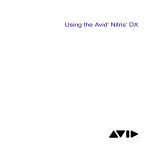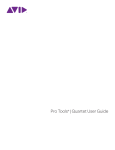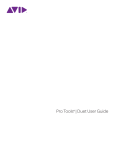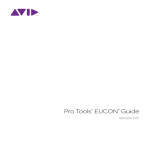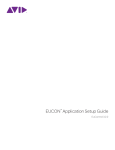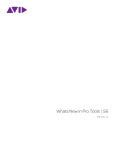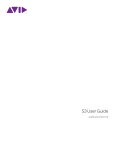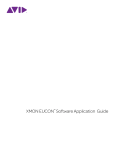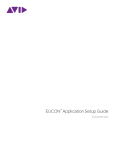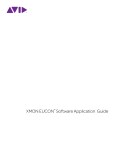Download Audio Authority Cat 5 HDMI Extender HDP-11 Product specifications
Transcript
Using the Avid Mojo DX ® ® Legal Notices Product specifications are subject to change without notice and do not represent a commitment on the part of Avid Technology, Inc. The software described in this document is furnished under a license agreement. You can obtain a copy of that license by visiting Avid's Web site at www.avid.com. The terms of that license are also available in the product in the same directory as the software. The software may not be reverse assembled and may be used or copied only in accordance with the terms of the license agreement. It is against the law to copy the software on any medium except as specifically allowed in the license agreement. This product may be protected by one or more U.S. and non-U.S patents. Details are available at www.avid.com/patents. This document is protected under copyright law. An authorized licensee of Avid Mojo DX may reproduce this publication for the licensee’s own use in learning how to use the software. This document may not be reproduced or distributed, in whole or in part, for commercial purposes, such as selling copies of this document or providing support or educational services to others. This document is supplied as a guide for Avid Mojo DX. Reasonable care has been taken in preparing the information it contains. However, this document may contain omissions, technical inaccuracies, or typographical errors. Avid Technology, Inc. does not accept responsibility of any kind for customers’ losses due to the use of this document. Product specifications are subject to change without notice. Copyright © 2013 Avid Technology, Inc. and its licensors. All rights reserved. Attn. Government User(s). Restricted Rights Legend U.S. GOVERNMENT RESTRICTED RIGHTS. This Software and its documentation are “commercial computer software” or “commercial computer software documentation.” In the event that such Software or documentation is acquired by or on behalf of a unit or agency of the U.S. Government, all rights with respect to this Software and documentation are subject to the terms of the License Agreement, pursuant to FAR §12.212(a) and/or DFARS §227.7202-1(a), as applicable. Trademarks 003, 192 Digital I/O, 192 I/O, 96 I/O, 96i I/O, Adrenaline, AirSpeed, ALEX, Alienbrain, AME, AniMatte, Archive, Archive II, Assistant Station, AudioPages, AudioStation, AutoLoop, AutoSync, Avid, Avid Active, Avid Advanced Response, Avid DNA, Avid DNxcel, Avid DNxHD, Avid DS Assist Station, Avid Ignite, Avid Liquid, Avid Media Engine, Avid Media Processor, Avid MEDIArray, Avid Mojo, Avid Remote Response, Avid Unity, Avid Unity ISIS, Avid VideoRAID, AvidRAID, AvidShare, AVIDstripe, AVX, Beat Detective, Beauty Without The Bandwidth, Beyond Reality, BF Essentials, Bomb Factory, Bruno, C|24, CaptureManager, ChromaCurve, ChromaWheel, Cineractive Engine, Cineractive Player, Cineractive Viewer, Color Conductor, Command|24, Command|8, Control|24, Cosmonaut Voice, CountDown, d2, d3, DAE, D-Command, D-Control, Deko, DekoCast, D-Fi, D-fx, Digi 002, Digi 003, DigiBase, Digidesign, Digidesign Audio Engine, Digidesign Development Partners, Digidesign Intelligent Noise Reduction, Digidesign TDM Bus, DigiLink, DigiMeter, DigiPanner, DigiProNet, DigiRack, DigiSerial, DigiSnake, DigiSystem, Digital Choreography, Digital Nonlinear Accelerator, DigiTest, DigiTranslator, DigiWear, DINR, DNxchange, Do More, DPP-1, D-Show, DSP Manager, DS-StorageCalc, DV Toolkit, DVD Complete, D-Verb, Eleven, EM, Euphonix, EUCON, EveryPhase, Expander, ExpertRender, Fader Pack, Fairchild, FastBreak, Fast Track, Film Cutter, FilmScribe, Flexevent, FluidMotion, Frame Chase, FXDeko, HD Core, HD Process, HDpack, Home-to-Hollywood, HYBRID, HyperSPACE, HyperSPACE HDCAM, iKnowledge, Image Independence, Impact, Improv, iNEWS, iNEWS Assign, iNEWS ControlAir, InGame, Instantwrite, Instinct, Intelligent Content Management, Intelligent Digital Actor Technology, IntelliRender, Intelli-Sat, Intelli-sat Broadcasting Recording Manager, InterFX, Interplay, inTONE, Intraframe, iS Expander, iS9, iS18, iS23, iS36, ISIS, IsoSync, LaunchPad, LeaderPlus, LFX, Lightning, Link & Sync, ListSync, LKT-200, Lo-Fi, MachineControl, Magic Mask, Make Anything Hollywood, make manage move | media, Marquee, MassivePack, Massive Pack Pro, Maxim, Mbox, Media Composer, MediaFlow, MediaLog, MediaMix, Media Reader, Media Recorder, MEDIArray, MediaServer, MediaShare, MetaFuze, MetaSync, MIDI I/O, Mix Rack, Moviestar, MultiShell, NaturalMatch, NewsCutter, NewsView, NewsVision, Nitris, NL3D, NLP, NSDOS, NSWIN, OMF, OMF Interchange, OMM, OnDVD, Open Media Framework, Open Media Management, Painterly Effects, Palladium, Personal Q, PET, Podcast Factory, PowerSwap, PRE, ProControl, ProEncode, Profiler, Pro Tools, Pro Tools|HD, Pro Tools LE, Pro Tools M-Powered, Pro Transfer, QuickPunch, QuietDrive, Realtime Motion Synthesis, Recti-Fi, Reel Tape Delay, Reel Tape Flanger, Reel Tape Saturation, Reprise, Res Rocket Surfer, Reso, RetroLoop, Reverb One, ReVibe, Revolution, rS9, rS18, RTAS, Salesview, Sci-Fi, Scorch, ScriptSync, SecureProductionEnvironment, Serv|GT, Serv|LT, Shape-to-Shape, ShuttleCase, Sibelius, SimulPlay, SimulRecord, Slightly Rude Compressor, Smack!, Soft SampleCell, Soft-Clip Limiter, SoundReplacer, SPACE, SPACEShift, SpectraGraph, SpectraMatte, SteadyGlide, Streamfactory, Streamgenie, StreamRAID, SubCap, Sundance, Sundance Digital, SurroundScope, Symphony, SYNC HD, SYNC I/O, Synchronic, SynchroScope, Syntax, TDM FlexCable, TechFlix, Tel-Ray, Thunder, TimeLiner, Titansync, Titan, TL Aggro, TL AutoPan, TL Drum Rehab, TL Everyphase, TL Fauxlder, TL In Tune, TL MasterMeter, TL Metro, TL Space, TL Utilities, tools for storytellers, Transit, TransJammer, Trillium Lane Labs, TruTouch, UnityRAID, Vari-Fi, Video the Web Way, VideoRAID, VideoSPACE, VTEM, Work-N-Play, Xdeck, X-Form, Xmon and XPAND! are either registered trademarks or trademarks of Avid Technology, Inc. in the United States and/or other countries. Using the Avid Mojo DX • 0130-07939-01 Rev D • April 2013 2 Contents Symbols and Conventions . . . . . . . . . . . . . . . . . . . . . . . . . . . . . . . . . . . . . . . . . . . . . 5 If You Need Help. . . . . . . . . . . . . . . . . . . . . . . . . . . . . . . . . . . . . . . . . . . . . . . . . . . . . 6 Accessing the Goodies Folder . . . . . . . . . . . . . . . . . . . . . . . . . . . . . . . . . . . . . . . . . . 7 Avid Training Services . . . . . . . . . . . . . . . . . . . . . . . . . . . . . . . . . . . . . . . . . . . . . . . . 7 Technical Support Information . . . . . . . . . . . . . . . . . . . . . . . . . . . . . . . . . . . . . . . . . . 7 Chapter 1 Using the Avid Mojo DX. . . . . . . . . . . . . . . . . . . . . . . . . . . . . . . . . . . . . . . . 9 How the Avid Mojo DX Handles Capture and Output . . . . . . . . . . . . . . . . . . . . . . . . . 9 Site Planning . . . . . . . . . . . . . . . . . . . . . . . . . . . . . . . . . . . . . . . . . . . . . . . . . . . . . . . 10 Rack Mounting the Avid Mojo DX Enclosure . . . . . . . . . . . . . . . . . . . . . . . . . . . . . . 11 Environmental and Safety Guidelines for Installing the Avid Mojo DX in a Rack 11 Installing the Avid Mojo DX in a Rack . . . . . . . . . . . . . . . . . . . . . . . . . . . . . . . . 12 Components for the Avid Mojo DX . . . . . . . . . . . . . . . . . . . . . . . . . . . . . . . . . . . . . . 16 Avid Mojo DX Front Panel. . . . . . . . . . . . . . . . . . . . . . . . . . . . . . . . . . . . . . . . . . . . . 16 Avid Mojo DX Rear Panel . . . . . . . . . . . . . . . . . . . . . . . . . . . . . . . . . . . . . . . . . . . . . 18 Synchronizing Audio and Video Equipment . . . . . . . . . . . . . . . . . . . . . . . . . . . . . . . 19 Specifications for the Avid Mojo DX . . . . . . . . . . . . . . . . . . . . . . . . . . . . . . . . . . . . . 20 Chapter 2 Configuring and Connecting Avid Editing Systems. . . . . . . . . . . . . . . . 23 System Connections and Configurations . . . . . . . . . . . . . . . . . . . . . . . . . . . . . . . . . 23 Installing the PCIe Host Interface Board (HIB). . . . . . . . . . . . . . . . . . . . . . . . . . 23 Installing the PCI ExpressCard for Laptop Use . . . . . . . . . . . . . . . . . . . . . . . . . 23 Connecting the Avid Mojo DX . . . . . . . . . . . . . . . . . . . . . . . . . . . . . . . . . . . . . . 24 Connecting the Keyboard and Mouse . . . . . . . . . . . . . . . . . . . . . . . . . . . . . . . . 26 Connecting the Monitors . . . . . . . . . . . . . . . . . . . . . . . . . . . . . . . . . . . . . . . . . . 26 Storage Options and Drive Striping. . . . . . . . . . . . . . . . . . . . . . . . . . . . . . . . . . . . . . 27 Connecting to Local Storage . . . . . . . . . . . . . . . . . . . . . . . . . . . . . . . . . . . . . . . 27 Avid VideoRAID ST and Avid VideoRAID SRs . . . . . . . . . . . . . . . . . . . . . . . . . 28 Avid MediaDock Ultra320 Informations . . . . . . . . . . . . . . . . . . . . . . . . . . . . . . . 28 Avid Shared Storage Environment . . . . . . . . . . . . . . . . . . . . . . . . . . . . . . . . . . 28 Formatting and Striping Media Drives (Windows) . . . . . . . . . . . . . . . . . . . . . . . 29 Formatting and Striping Media Drives (Macintosh) . . . . . . . . . . . . . . . . . . . . . . 29 Moving Striped Drives to Another System (Macintosh Only). . . . . . . . . . . . . . . 30 Connecting Cameras, Decks, and Monitors. . . . . . . . . . . . . . . . . . . . . . . . . . . . . . . 30 Connecting Video Devices — Summary . . . . . . . . . . . . . . . . . . . . . . . . . . . . . . 31 Connecting a Video Deck — Serial Digital Signal . . . . . . . . . . . . . . . . . . . . . . . 31 Connecting a Client Monitor . . . . . . . . . . . . . . . . . . . . . . . . . . . . . . . . . . . . . . . 32 Support Output Formats . . . . . . . . . . . . . . . . . . . . . . . . . . . . . . . . . . . . . . . . . . 32 Appendix A Regulatory and Safety Notices . . . . . . . . . . . . . . . . . . . . . . . . . . . . . . . . . 33 Warnings and Cautions . . . . . . . . . . . . . . . . . . . . . . . . . . . . . . . . . . . . . . . . . . . . . . 33 FCC Notice. . . . . . . . . . . . . . . . . . . . . . . . . . . . . . . . . . . . . . . . . . . . . . . . . . . . . . . . 33 Safety Compliance . . . . . . . . . . . . . . . . . . . . . . . . . . . . . . . . . . . . . . . . . . . . . . . . . . 33 Canadian ICES-003 . . . . . . . . . . . . . . . . . . . . . . . . . . . . . . . . . . . . . . . . . . . . . . . . . 34 LED Safety Notices . . . . . . . . . . . . . . . . . . . . . . . . . . . . . . . . . . . . . . . . . . . . . . . . . 34 Disposal of Waste Equipment by Users in the European Union . . . . . . . . . . . . . . . 34 Australia and New Zealand EMC Regulations . . . . . . . . . . . . . . . . . . . . . . . . . . . . . 34 Taiwan EMC Regulations. . . . . . . . . . . . . . . . . . . . . . . . . . . . . . . . . . . . . . . . . . . . . 35 Korean EMC Regulations. . . . . . . . . . . . . . . . . . . . . . . . . . . . . . . . . . . . . . . . . . . . . 35 Class A Equipment . . . . . . . . . . . . . . . . . . . . . . . . . . . . . . . . . . . . . . . . . . . . . . 35 Japan EMC Regulations. . . . . . . . . . . . . . . . . . . . . . . . . . . . . . . . . . . . . . . . . . . . . . 35 Class A Equipment . . . . . . . . . . . . . . . . . . . . . . . . . . . . . . . . . . . . . . . . . . . . . . 35 4 Using This Guide Important Information Avid recommends that you read all the information in this document before connecting or using your new hardware and software. The following topics explain how to use and connect cables and devices to the Avid input/output hardware device and how to connect specific devices to an Avid-supported PC or Macintosh system that the Avid hardware is connected to. The PC and Macintosh systems supported for your Avid input/output hardware can change at any time. Unless noted otherwise, the material in this document applies to the Windows® XP, Windows Vista®, and Mac OS® X operating systems.The majority of screen shots in this document were captured on a Windows system, but the information applies to both Windows and Mac OS X systems. Where differences exist, both Windows and Mac OS X screen shots are shown. n Please look at the ReadMe file that installs with the application. It contains important information that you should use in conjunction with the information presented in these topics. Symbols and Conventions Avid documentation uses the following symbols and conventions: Symbol or Convention Meaning or Action n A note provides important related information, reminders, recommendations, and strong suggestions. c A caution means that a specific action you take could cause harm to your computer or cause you to lose data. w A warning describes an action that could cause you physical harm. Follow the guidelines in this document or on the unit itself when handling electrical equipment. Symbol or Convention Meaning or Action > This symbol indicates menu commands (and subcommands) in the order you select them. For example, File > Import means to open the File menu and then select the Import command. This symbol indicates a single-step procedure. Multiple arrows in a list indicate that you perform one of the actions listed. (Windows), (Windows only), (Macintosh), or (Macintosh only) This text indicates that the information applies only to the specified operating system, either Windows or Macintosh OS X. Bold font Bold font is primarily used in task instructions to identify user interface items and keyboard sequences. Italic font Italic font is used to emphasize certain words and to indicate variables. Courier Bold font Courier Bold font identifies text that you type. Ctrl+key or mouse action Press and hold the first key while you press the last key or perform the mouse action. For example, Command+Option+C or Ctrl+drag. If You Need Help If you are having trouble using your Avid product: 1. Retry the action, carefully following the instructions given for that task in this guide. It is especially important to check each step of your workflow. 2. Check the latest information that might have become available after the documentation was published: - If the latest information for your Avid product is provided as printed release notes, they ship with your application and are also available online. If the latest information for your Avid product is provided as a ReadMe file, it is supplied on your Avid installation CD or DVD as a PDF document (README_product.pdf) and is also available online. You should always check online for the most up-to-date release notes or ReadMe because the online version is updated whenever new information becomes available. To view these online versions, select ReadMe from the Help menu, or visit the Knowledge Base at www.avid.com/readme. 3. Check the documentation that came with your Avid application or your hardware for maintenance or hardware-related issues. 6 Accessing the Goodies Folder 4. Visit the online Knowledge Base at www.avid.com/onlinesupport. Online services are available 24 hours per day, 7 days per week. Search this online Knowledge Base to find answers, to view error messages, to access troubleshooting tips, to download updates, and to read or join online message-board discussions. Accessing the Goodies Folder Avid supplies a Goodies folder located on the editing application DVD. Access the Goodies folder by browsing the DVD. This folder contains programs and files you might find useful when trying to perform functions beyond the scope of your Avid editing application. The information in the Goodies folder is provided solely for your reference and as suggestions for you to decide if any of these products fit into your process. Avid is not responsible for the manufacture, support, or sales of these products. Avid is also not responsible for any loss of data or time, or any other adverse results related to the use of these products. All risks of using such products or accessing such Web sites are entirely your own. The Web sites listed in the Goodies folder are not under the control of Avid, and Avid is not responsible for their content, any changes or updates to them, or the collection of any personal data or information by the operators of such Web sites. All information and product availability is subject to change without notice. Avid Training Services Avid makes lifelong learning, career advancement, and personal development easy and convenient. Avid understands that the knowledge you need to differentiate yourself is always changing, and Avid continually updates course content and offers new training delivery methods that accommodate your pressured and competitive work environment. For information on courses/schedules, training centers, certifications, courseware, and books, please visit www.avid.com/training or call Avid Sales at 800-949-AVID (800-949-2843). Technical Support Information Most products feature a number of coverage options. Avid Assurance service offerings are designed to facilitate your use of Avid solutions. Service options include extended telephone coverage, automatic software maintenance, extended hardware warranty, and preferred pricing on replacement parts. For more information regarding Avid’s service offerings, visit www.avid.com/support or call Avid Sales at 800-949-AVID (800-949-2843). 7 Program availability and details might vary depending on geographic location and are subject to change without notice. Contact your local Avid office or your local Avid Reseller for complete program information and pricing. However, if you need help locating an Avid office or Avid Reseller near you, please visit www.avid.com or call in North America 800-949-AVID (800-949-2843). International users call 978-275-2480. 8 1 Using the Avid Mojo DX This chapter provides general information about your Avid input/output hardware in the following main topics: • How the Avid Mojo DX Handles Capture and Output • Site Planning • Rack Mounting the Avid Mojo DX Enclosure • Components for the Avid Mojo DX • Avid Mojo DX Front Panel • Avid Mojo DX Rear Panel • Synchronizing Audio and Video Equipment • Specifications for the Avid Mojo DX How the Avid Mojo DX Handles Capture and Output The Avid input/output hardware captures and outputs video and audio from external equipment such as cameras and decks. The hardware accepts video and audio in different formats and resolutions, and changes these formats and resolutions to Avid-specific data for transfer to the Avid editing system. Data transfer uses an Avid-specific protocol that describes the format and resolution of the media you are capturing. Once the data is on your Avid editing system, you edit in your Avid editing application, and then return the data to the Avid input/output hardware, where it is converted to the format and resolution required for video and audio output. Avid Mojo DX captures and outputs SD and HD video and audio, and connects to an Avid editing system via a Host Interface Board (HIB). Avid Mojo DX captures SD and HD video material in digital format via the Serial Digital Interface (SDI) connectors, and captures audio in digital Sony®/Philips® Digital Interconnection Format/Alesis® Digital Audio Tape (SPDIF/ADAT) and as SDI embedded audio as well as through analog 1/4” TRS connectors. 1 Using the Avid Mojo DX Avid Mojo DX outputs SD and HD video material in digital format via an SDI connector. A High-Definition Multimedia Interface (HDMI™) connector provides easy hook-up to HD displays. Avid Mojo DX outputs audio in SPDIF/ADAT format and as SDI embedded audio, as well as through analog 1/4” TRS connectors. Site Planning When preparing your site, you must consider the environmental, electrical, and space requirements for your Avid Mojo DX workstation, as well as for any additional equipment. Before setting up your system, see the ReadMe provided with your Avid editing application to make sure that there are no changes to the information in this document. For instructions on setting up workstation hardware, see the setup documentation provided with the workstation. For a rackmount workstation, you must install the workstation into a standard rack before connecting the hardware. To prevent equipment damage that might be caused by static electricity, do all of the following before making any connections: • Always use anti-static protection. • Always connect devices to a properly grounded outlet. • Turn off all devices. • Touch the metal casing of the device before handling any circuit boards. Environmental Requirements The site you choose for your Avid Mojo DX workstation should meet the following environmental requirements: 10 • Site is clean and dust free. • Site is free from significant temperature or humidity changes. • Site is sturdy, level, and not subject to vibration. • Site is away from radio frequency emissions, high-traffic, or high-noise areas. • Site provides adequate space in front of and behind the workstation components, so you can connect cables and service your workstation. This also provides adequate airflow for cooling. • Site provides a minimum clearance of 3 inches (7.6 cm) for the side and back panels of the deskside base unit. • Site for the editing workstation is a table (or other surface) that is at least 60 inches wide by 48 inches deep (150 cm × 120 cm). Rack Mounting the Avid Mojo DX Enclosure Electrical Requirements Your site should meet the following electrical requirements: • Site has adequate, grounded, power outlets for the Avid Mojo DX. This prevents the need for extension cords. • Site is away from major electrical equipment such as motors, air conditioners, or elevators. • Site is not subject to static electrical buildup. Avid recommends the use of an uninterruptible power supply (UPS) appropriately sized for your system configuration. The UPS provides system protection against sudden power surges or losses that could cause you to lose your work. n Plug only the Avid Mojo DX and other system equipment into the power strip. Do not plug in coffee makers, radios, lights, or other non-Avid devices. For information on the electrical specifications of your Avid editing system and your Avid Mojo DX input/output hardware, see “Specifications for the Avid Mojo DX” on page 20. Rack Mounting the Avid Mojo DX Enclosure This section describes how to mount the Avid Mojo DX in a 19-inch (483-mm) National Electrical Manufacturers Association (NEMA®) or Electronics Industry Association (EIA) rack. Avid recommends that you mount your Avid Mojo DX in a rack before you connect any cables. n If you need to rack mount the HP workstation, a rack-mount kit with installation instructions is available from HP. The HP Workstation system requires five rack units. Environmental and Safety Guidelines for Installing the Avid Mojo DX in a Rack When you install the Avid Mojo DX in a rack, you must take precautions against the following hazards: Hazard Description Elevated Operating Ambient Temperature When the Avid Mojo DX is installed in a closed or multiunit rack assembly, the operating ambient temperature of the rack environment might be greater than the room ambient temperature. Therefore, consider installing the equipment compatible with the manufacturer’s maximum ambient temperature of 104ºF (40ºC). 11 1 Using the Avid Mojo DX Hazard Description Reduced Airflow Do not compromise the amount of airflow required for safe operation of the equipment. Mechanical Loading Avoid a hazardous condition due to an uneven mechanical loading. Circuit Overloading Consider connecting the equipment to the supply circuit and the effect that overloading of circuits might have on overcurrent protection and supply wiring. Use appropriate equipment nameplate ratings. Reliable Grounding Maintain reliable grounding of rack-mounted equipment. Give particular attention to supply connections other than direct connections to the branch circuit (for example, use power strips). Installing the Avid Mojo DX in a Rack The Avid Mojo DX is designed for 19-inch (483-mm) rack enclosures and requires one EIA rack unit (2RU), or 1.75 inches (44.4 mm) of rack space. The Avid Mojo DX ships with a rackmount accessory kit that includes rack-nut clips for rack enclosures that do not have threaded holes. Threaded rack-nut clips slide into the holes of the rack and provide threaded holes to secure the rack components. The rack-mounting kit also includes rack-mounting ears, an Allen wrench, and rack screws. The Avid Mojo DX ships configured for desktop use. To rackmount the unit you must remove the support feet and install the rack-mounting ears. c To ensure the stability of the rack enclosure, start from the bottom when you install the rack components in the rack enclosure. c Have someone help you to lift the Avid Mojo DX enclosure. To prepare the Avid Mojo DX for rackmounting: 1. Unscrew each of the hex screws from the four support feet using the Allen wrench, and set the screws aside. 2. Remove the four support feet from the Avid Mojo DX and set them aside. 12 Rack Mounting the Avid Mojo DX Enclosure c Syn AT TN z DIO AU Ho st Lin k I -SD HD I -SD SD Removing the support feet from the Avid Mojo DX. 3. Position the front rack-mounting ears on the Avid Mojo DX by sliding the slot tab (metal tab) on the rack-mounting ear into the slot on each side of the Avid Mojo DX (see the following illustration). c Syn AT TN DIO z AU k Ho st Lin I -SD HD I -SD SD Attaching the front rack-mounting ears to the Avid Mojo DX. Note the locations of the slot tab on each ear (top right) and the matching slots on the Avid Mojo DX (bottom left). 4. Secure the rack-mounting ears to the Avid Mojo DX chassis using the Allen wrench. 13 1 Using the Avid Mojo DX To install the Avid Mojo DX in a rack: 1. Select the position in the rack where you can mount the Avid Mojo DX, and position the Avid Mojo DX so the bottom of the enclosure is at the baseline of a U-alignment position (see the following illustration). 5/8 in 5/8 in 1/2 in 5/8 in 5/8 in 1/2 in 5/8 in 5/8 in 1/2 in 1 3/4 in 1U 5/8 in 5/8 in 1/2 in Positioning the Avid Mojo DX in a rack enclosure. The Avid Nitris DX requires one EIA rack unit of space, as shown on the left. Align the baseline of the Avid Mojo DX at a U-alignment position between two 1/2-inch holes on the rack mounting rail, as shown on the right. 2. (Option for rack enclosures without threaded holes) From the inside of the enclosure rail, slide the rack-nut clip over each hole you want to use. Each front support rail needs 2 rack-nut clips for the front of the Avid Mojo DX. 14 Rack Mounting the Avid Mojo DX Enclosure Attaching rack-nut clips onto the rack enclosure. From the inside of the enclosure rail, the clip slides over the hole that you want to use when you mount the Avid Mojo DX. z 3. From the front of the rack, position the Avid Mojo DX so that it is flush against the front mounting rails. Securing the Avid Mojo DX in a rack enclosure. Screws pass through the front of the Avid Mojo DX and into the front mounting rail of the rack enclosure. 4. Align the holes in the Avid Mojo DX with the holes in the front mounting rail. 5. Insert the screws through the front of the Avid Mojo DX and the front mounting rail, and tighten them. 15 1 Using the Avid Mojo DX Components for the Avid Mojo DX This topic lists the main components of the Avid Mojo DX as well as the cables and media supplied by Avid. Main Components The Avid Mojo DX consists of: • The Avid Mojo DX enclosure The enclosure contains video and audio I/O connectors, sync and word clock connectors, a Peripheral Component Interconnect Express (PCIe®) cable connector, a headphone socket with volume control, and an autosensing power supply • A 4-lane PCIe Host Interface Board (HIB) The Host Interface Board connects the Avid Mojo DX to qualified Windows and Macintosh workstations. Avid offers an optional 1-lane PCI ExpressCard® for connecting the Avid Mojo DX to qualified Windows and Macintosh® notebooks and laptops. Supplied Cables Avid Mojo DX is supplied with a PCIe cable for connecting the Avid Mojo DX to the PCIe Host Interface Board. Optional cable items for workstations include a cable kit, two serial digital video cables, and two audio (1/4”) phono cables. Additional optional items for Macintosh® workstations are a Mac keyboard and a Mac cable kit. PDF Documentation Avid input/output hardware is supplied with a Using CD or DVD that includes this online document. See the Avid Customer Support Knowledge Base at www.avid.com/onlinesupport for the most up-to-date version of this document. The installation poster for your Avid input/output hardware provides detailed instructions on initial software installation. Avid Mojo DX Front Panel This topic describes the front panels and LEDs of the Avid input/output hardware products supported for use with your Avid editing application. 16 Avid Mojo DX Front Panel Avid Mojo DX Front Panel Host Link Sync ATTN HD-SDI SD-SDI AUDIO Sync z Host Link HD-SDI SD-SDI ATTN AUDIO Avid Mojo DX front panel. Top, left and right: status LEDs. Top center: power LED, volume control knob, and headphone output. Bottom: location of power button. The Avid Mojo DX automatically turns on or off when you turn on or shut down your system. You do not need to turn on the Avid Mojo DX separately. LED Color Indication and Status Power • Amber: Standby mode. AC power has been applied. • Green: Host PC has been powered up or Avid Mojo DX has been turned on via power switch. • Green: Host connected, driver communicating with unit. • Green/Amber: Host connected, PCIe negotiated only, no driver communication. • Amber: No host connection. • Off: Power off. • Green: HD-SDI input selected, correct format present. • Green/Amber: HD-SDI input selected, input missing or incorrect format. • Amber: HD-SDI input present, but not selected. • Off: HD-SDI input not selected, no input present. • Green: SD-SDI input selected, correct format present. • Green/Amber: SD-SDI input selected, incorrect format present. • Amber: SD-SDI input present, but not selected. • Off: SD-SDI input not selected, no input present. Host Link HD-SDI SD-SDI 17 1 Using the Avid Mojo DX LED Color Indication and Status SYNC • Green: Reference selected and correct format detected. • Green/Amber: Reference selected, input missing or incorrect format. • Amber: Reference present, but not selected. • Off: Reference not selected, and no input present. • Green: No system errors detected. • Amber: System error detected (Temperature range exceeded (fan speed), PCIe error, NIOS error or fall back to fail-safe flash image). • Green: Audio present at selected input, digital source at correct sample rate. • Green/Amber: Audio not present at selected input or digital audio source at incorrect sample rate. • Amber: Audio input present, but not selected. • Off: Audio input not selected and no input present. ATTN AUDIO Avid Mojo DX Rear Panel This topic describes the rear panel of the Avid Mojo DX. SERIAL CH 1 IN SDI OUT SPDF/ADAT CH 2 IN 1 OUT 2 HOST PCIe HDMI OUT 3 4 REF SYNC AUD CLK OUT 5 6 IN OUT 7 ANALOG AUDIO 8 Avid Mojo DX rear panel Number Label Connector Type Function 1 SERIAL DB-9 2 SDI IN/OUT BNC (2) 18 n Console serial port used for manufacturing purposes. This serial port cannot be used for deck connections. These two connectors provide dual rate SD/HD SMPTE 292/259M SDI, primary I/O. Synchronizing Audio and Video Equipment Connector Type Function Number Label n Embedded audio support is provided via the HD and SD SDI connectors. The number of available audio channels is defined by your Avid editing application. 3 HOST PCIe PCIe Host Interface Connection to workstation. 4 HDMI OUT HDMI HDMI Out. 5 REF SYNC BNC (1) Reference is input only, black burst or Tri-level Sync. 6 WORD CLOCK OUT BNC Audio word clock output (lrclk)/electrical SPDIF output (can be configured to provide a word clock output or SPDIF audio output). 7 SPDIF/ADAT IN/OUT Toslink (dual) S/PDIF any 2 channel pair in/out or ADAT (user selectable in the editor application). n 8 ANALOG AUDIO IN/OUT Dual 1/4” TRS Standard to which conformity is declared: (Class 1 LED Product per IEC 60825-1:2007) Analog audio, 2 channels. Synchronizing Audio and Video Equipment You select synchronization source in the Video Output tool. The two choices are reference or internal. If reference is selected, the Avid Mojo DX locks to either black burst or Tri-level, whichever is connected. If internal is selected, or if there is no black burst or Tri-level connected, the Avid Mojo DX generates its own reference. The following table summarizes how synchronization works. Sync Type Description Audio/Video Sync During Capture When you capture audio and video together, they must be synchronized to each other external to the Avid Mojo DX. When you capture from a single device such as a VTR, no special considerations are necessary. When you capture audio and video from separate sources simultaneously, the audio and video sources must be synchronized, typically with the house reference signal, in order to maintain audio/video synchronization (lip sync). 19 1 Using the Avid Mojo DX Sync Type Description Video Reference Sync In order to ensure the audio and video outputs of the Avid Mojo DX are in sync with external equipment (VTR, or video distribution equipment), the reference sync input must be connected to a valid sync source, either black burst or tri-level at the appropriate frame rate, common with the external equipment. The reference input is internally terminated to 75ohms. If synchronization with external equipment is not required, the reference sync input can be left unconnected. Video Reference IN (REF) Sync signals can be either black burst or Tri-level. If there is no sync connected to REF, an internal sync is used. When using SD video, synchronization is only required when the output must be synchronized to some other external equipment. When using HD video, you can use either black burst or tri-level sync on the ref sync connector. n If you are using one black burst connector, you must use a terminator. The Avid Mojo DX does not include two separate connectors for black burst or Tri-level. Specifications for the Avid Mojo DX Dimensions Hardware component Dimensions (Inches) Dimensions (Centimeters) Avid Mojo DX configuration (Desktop) Height: 2.26 (including feet) Width: 14.6 Depth: 10.6 Height: 5.58 Width: 37.0 Depth: 26.9 Avid Mojo DX Height: 1.7 configuration (Rackmount) Width: 19.0 — Rack Units: 2 Depth: 10.3 Height: 4.31 Width: 48.2 Depth: 26.1 Avid Mojo DX 6 lb 15 oz (3.15 kg) Weight: Electrical Specifications Component Voltage Frequency Watts Avid Mojo DX 100 to 240 V ac 50 to 60 Hz Normal operating power: 30w Heavy load: 45w 20 Specifications for the Avid Mojo DX Component Voltage Frequency Watts Hewlett-Packard (HP) workstation 100 to 240 V ac auto-ranging 50 to 60 Hz See the HP website for specific information on power consumption. Monitors 100 to 250 V ac 50 to 60 Hz See the manufacturer’s website for specific information on power consumption. Avid VideoRAID® SR 8-drives 100 to 240 V ac 50 to 60 Hz Normal operating power: 200w Heavy load: 375w 16-drives Avid VideoRAID® ST 5-drives Normal operating power: 300w Heavy load: 575w 100 to 240 V ac 50 to 60 Hz Normal operating power: 150w Heavy load: 200w 21 1 Using the Avid Mojo DX 22 2 Configuring and Connecting Avid Editing Systems This chapter provides information about the following configuration and connection topics: • System Connections and Configurations • Storage Options and Drive Striping • Connecting Cameras, Decks, and Monitors System Connections and Configurations The following topics provide information about connecting equipment to your system. For a list of supported hardware, see the ReadMe for your Avid editing application. Installing the PCIe Host Interface Board (HIB) The Avid Mojo DX connects to your workstation via a PCIe cable which ships with the Avid Mojo DX. The PCIe cable connects from the Avid Mojo DX to a PCIe HIB you install in your workstation. See the manufacturer’s documentation provided with your workstation for detailed instructions on installing additional boards and for the location of your workstation’s PCIe slot. c You must use anti-static precautions, for example, an anti-static mat, or an anti-static wrist or ankle strap, when handling hardware components and boards. Never touch any exposed electrical connectors on the components as they can be damaged by electrostatic discharge (ESD). Installing the PCI ExpressCard for Laptop Use If you are using a laptop with the Avid Mojo DX, you need to plug in Avid’s PCI ExpressCard in your laptop. The PCI ExpressCard is a 1-lane PCI HIB ExpressCard. To install the PCI ExpressCard into your laptop: 1. Ensure that you are using appropriate anti-static precautions. 2. Power off and unplug your laptop. 3. Remove the PCI ExpressCard from the anti-static package. System Connections and Configurations PCIe x4 Host Interface Board ExpressCard Laptop PCIe Express Card 4. Identify the laptop slot into which you want to install the PCI ExpressCard. 5. Carefully position the PCI ExpressCard into the expansion slot and snap the PCI ExpressCard into place. Connecting the Avid Mojo DX The Avid Mojo DX connects via a PCIe cable to a PCIe Host Interface Board (HIB) installed in your workstation. The PCIe HIB ships with the Avid Mojo DX. For detailed instructions on installing the PCIe HIB, see the setup documentation provided with your workstation. c The PCIe cable and connector are keyed so they can only be plugged in one way. Always use the release ring when removing the PCIe cable as failure to do so might result in equipment damage. To connect the Avid Mojo DX to your workstation: 1. Plug one end of the PCIe cable into the rear of the workstation at the PCIe HIB connector or, for a laptop computer, into the PCI Express Card. PCIe cable The PCIe cable clicks into place. 2. Plug the other end of the PCIe cable into the rear of the Avid Mojo DX at the HOST PCIe connector. 24 System Connections and Configurations The PCIe cable clicks into place. The following illustration shows an example connection. Your specific configuration might vary. SERIAL CH 1 IN OUT SPDF/ADAT CH 2 IN OUT HOST PCIe HDMI OUT REF SYNC AUD CLK OUT IN OUT ANALOG AUDIO HOST PCIe S A S Connecting an Avid Mojo DX 3. Attach the power cord to the power connector to the rear of the Avid Mojo DX and plug the other end into a grounded power outlet. n When the Avid Mojo DX is plugged into a power outlet, the Avid Mojo DX goes into standby mode and the Power LED turns amber. For more information, see “Avid Mojo DX Front Panel” on page 16. The Avid Mojo DX automatically turns on when the workstation or laptop is turned on. You do not need to turn on the Avid Mojo DX separately. 4. Turn on your workstation and install your Avid editing application (if necessary). See the “Read Before Installing” sheet supplied with your Avid editing application. 5. Start your Avid editing application, for example, by doing one of the following: t (Windows) Double-click the Avid editing application icon on the desktop. t (Macintosh) Double-click the Avid editing application icon on the Dock. Allow your Avid editing application to update the newly installed hardware. The Power LED and Host Link LED turn green and you are ready to use the Avid Mojo DX. n For detailed instructions on initial software installation, see the Avid Mojo DX poster that ships with the hardware enclosure. 25 System Connections and Configurations Connecting the Keyboard and Mouse Attach your keyboard and mouse according to the instructions provided with the manufacturer’s documentation. n Avid does not recommend using extension cables more than 6 feet (1.83 meters) for your keyboard and mouse. Connecting the Monitors Your workstation can connect with two monitors. Avid recommends Avid Mojo DX flat-panel Digital Video Interface (DVI) monitors. The monitors connect to the NVIDIA graphics board. n On a rackmount workstation, the graphic boards are to the left when you look at the back of the workstation base unit. To connect the monitors: 1. Verify that the power is turned off on the monitor and the workstation, and then connect these devices to a power source. 2. Attach one end of the cable to the monitor (use an adapter if needed). 3. Attach the other end of the cable to the appropriate DVI connector (use an adapter if needed). S A S Example of video board monitor connections 26 Storage Options and Drive Striping Storage Options and Drive Striping Your storage options include connecting to a local SCSI storage system or to an Avid shared storage environment. Some storage options require you to configure and stripe your drives. Connecting to Local Storage Avid Mojo DX editing systems support the following local storage enclosures: n • Avid VideoRAID ST and Avid VideoRAID SR (SAS connection) • Avid MediaDock rS Ultra 320 (fixed SCSI drives) and Avid MediaDock Ultra320 • Avid VideoRAID RTR-320 and RTR-320X as a local SCSI storage systems Local storage connects to the two SCSI channels at the rear of the workstation and must be striped to provide the needed throughput. S A S Example of SCSI connections at the rear of a system The connections at the rear of the workstation are HD 68-pin connectors. If you plan to use SCSI devices for standalone storage, you must order the supported SCSI expansion cards and cables separately when you order your Avid editing system. For the latest list of supported devices and cables, see your Avid sales representative. The maximum length of the external SCSI cables must not exceed 16-feet (5 meters). If you connect two MediaDock Ultra320 enclosures (one enclosure on each SCSI channel) you can use a 16-foot (5 meter) SCSI cable on each SCSI channel. 27 Storage Options and Drive Striping Avid typically supports newer drives as they become available. For the latest list of supported drives, see your Avid sales representative. Avid VideoRAID ST and Avid VideoRAID SRs For installation procedures and instructions for installing either the Avid VideoRAID ST or the Avid VideoRAID SR local storage, see the documentation that ships with the Avid VideoRAID ST or the Avid VideoRAID SR product. Avid MediaDock Ultra320 Informations For installation procedures and instructions on switching between single-bus and dual-bus modes, see the documentation that ships with the Avid MediaDock Ultra320. Avid Shared Storage Environment Avid shared storage media networks are shared storage and networking solutions for sharing media between multiple workstations. Depending on which environment you have, a specific media network board is installed in your Avid workstation. • For the latest network boards supported with your shared storage, see the Avid shared storage ReadMe. S A S Avid shared storage slot location. Top: location for an Ethernet connection. Bottom: location for a Fibre Channel connection. 28 Storage Options and Drive Striping Setup and installation instructions for the components ship with the Avid shared storage hardware. For information on installing the Avid network board driver, see the Avid shared storage documentation. Formatting and Striping Media Drives (Windows) Disk drives must be configured as Dynamic if you are striping drives. To configure and stripe drives: 1. Start your system, and log in to an account with administrative privileges. 2. Right-click the My Computer icon, and select Manage. The Computer Management window opens. 3. Click the Disk Management folder. For more information on the Computer Management window, click the Help icon in the toolbar of the Computer Management window. 4. Make a drive Dynamic by right-clicking the disk ID section of the disk in the Computer Management window and selecting Upgrade to Dynamic disk, or Create Dynamic disk, depending upon the status of your disk. When you select a disk in the Computer Management window, the white section of the disk changes to stripes, showing that the section has been selected. 5. Repeat step 4 for each drive you want to stripe. 6. Right-click one of the Dynamic drives and select Action > New Striped Volume. 7. Follow the instructions in the Create Volume Wizard to finish striping the drives using NTFS format. Formatting and Striping Media Drives (Macintosh) To use all the resolutions available in your Avid editing system, use the ATTO ExpressStripe™ software to stripe drives on the Mac OS X operating system. The ExpressStripe software is installed in the following location: /Applications/ExpressStripe The instructions for using the software are in a PDF file, Expressstripe.pdf, that is installed along with the ExpressStripe application. You must be logged in as an Administrator to stripe drives. 29 Connecting Cameras, Decks, and Monitors c Do not use the Apple Disk Utility application (in Applications/Utilities) to stripe drives. If you use the Disk Utility application, you will not be able to view the drives on the Mac OS 9 system. Additionally, Avid’s drive filtering feature will not function properly, resulting in poor performance. You need to be aware of certain considerations if you are using striped drives on both Mac OS X systems, and if you are moving striped drives between Macintosh systems. For more information, “Moving Striped Drives to Another System (Macintosh Only)” on page 30. Moving Striped Drives to Another System (Macintosh Only) In order to move striped drives to another system, you need to be able to identify the drives that make up a particular striped set. On Mac OS X, the system does not use the SCSI ID but instead uses its internal diskn name (where n is the drive number) when creating the striped sets. You can use Avid Storage Manager or ExpressStripe to identify a striped set on Mac OS X. To use Avid Storage Manager to identify a striped set: 1. Start the Avid Storage Manager application and select View > Volumes. 2. Select the striped volume you wish to move and click Identify. The system blinks the lights on the front of the drives that make up the volume. To use ExpressStripe to identify a striped set: 1. Start the ExpressStripe application. 2. In the opening dialog boxes, select Utilities and then select Benchmark. 3. Select the striped volume you want to move and click Start. The system runs the benchmark test on the volume and shows activity on the front of the drives that make up the volume. Connecting Cameras, Decks, and Monitors There are several possible cabling configurations depending on your camera, video deck, and client monitor. The audio and video output signals are available to each output connector at the same time. 30 Connecting Cameras, Decks, and Monitors Connecting Video Devices — Summary The following illustration and procedure summarize the connections you need to attach an HD VTR and video monitor. For more information, see the documentation that comes with your peripheral devices. For specific information on connecting video decks using a serial digital signal, see “Connecting a Video Deck — Serial Digital Signal” on page 31. To connect video devices to the Avid Mojo DX: 1. Connect the SDI Out on the Avid Mojo DX to the HD In on the VTR. 2. Connect the HDMI Out on the Avid Mojo DX to the HDMI In on the video monitor. n In the Avid Mojo DX workflow for SDI, there is only one input and one output so it can only be SD or HD. SDI and HDMI are independent outputs and need not match in resolution. SDI and HDMI output can be SD while the SDI is HD, and vice versa. The output configuration is set in the video output tool in your Avid editing application. Connecting a Video Deck — Serial Digital Signal A serial digital video deck connection requires the following: • Two serial digital cables with BNC connectors at both ends • A video deck with serial digital inputs and outputs SERIAL CH 1 IN SDI OUT SPDF/ADAT CH 2 IN OUT HOST PCIe HDMI OUT REF SYNC AUD CLK OUT IN OUT ANALOG AUDIO Connecting a video deck to the Avid Mojo DX — serial digital signal. Left: SDI IN connector (cabling goes to serial digital output connector on the deck). Right: SDI OUT connector (cabling goes to serial digital input connector on the deck). To connect a video deck using serial digital signals: 1. Locate one serial digital cable and attach one end of it to the SDI IN on the Avid Mojo DX (refer to the illustration above). 2. Attach the other end of the serial digital cable to the serial digital output of your video deck. 31 Connecting Cameras, Decks, and Monitors 3. Locate another serial digital cable and attach it to the SDI OUT on the Avid Mojo DX. 4. Attach the other end of the serial digital cable to the serial digital input of your video deck. n Make sure you terminate the input signal if your video deck supports passthrough. See the documentation that is provided with your video deck. Connecting a Client Monitor To view the video as it passes through the Avid Mojo DX, you might want to connect a client monitor. You can connect a Client monitor to the High-Definition Multimedia Interface (HDMI) Out output on the Avid Mojo DX. The HDMI connection is capable of transmitting uncompressed digital media (video and audio). Most video decks provide a video output connector. You can connect a monitor to the deck to see the video sent to the Avid Mojo DX or the video the Avid Mojo DX sends to the deck. See the documentation that came with your video deck for more information. c The video you see in the monitor connected to the deck might not indicate there is a video signal going to the Avid Mojo DX. Support Output Formats The following HD formats are supported for Avid Mojo DX: • 1080i/59.94 • 1080p/29.97 (transmitted as 1080PsF/29.97) • 1080i/50 This format is marginal on some monitors with a lower limit of 50-Hz for vertical refresh rate. Consult your VGA monitor specification for compliance with 50-Hz vertical refresh. • 1080p/23.976 (transmitted as 1080PsF) • 1080p/24 (transmitted as 1080PsF) • 1080p/25 (marginal - PsF) • 720p 50 • 720p/59.94 32 A Regulatory and Safety Notices Warnings and Cautions c c c c c Never install equipment if it appears damaged. Disconnect the power cord before servicing unit. Only perform the services explicitly described in this document. For services or procedures not outlined in this document, speak with authorized Avid service personnel. Follow all warnings and cautions in the procedures. Operate the device within its marked electrical ratings and product usage instructions. FCC Notice This equipment has been tested and found to comply with the limits for a Class A digital device, pursuant to Part 15 of the FCC rules. These limits are designed to provide reasonable protection against harmful interference when the equipment is operated in a commercial environment. This equipment generates, uses, and can radiate radio frequency energy and, if not installed and used in accordance with the instructions, may cause harmful interference to radio communications. Operation of this equipment in a residential area is likely to cause harmful interference, in which case the user will be required to correct the interference at personal expense. Any modifications to the unit, unless expressly approved by Avid, could void the user's authority to operate the equipment. Safety Compliance This equipment has been tested to comply with USA and Canadian safety certification in accordance with the specifications of UL Standards: UL 60950-1, 2nd Ed 2007/IEC 60950-1, 2nd Ed and CSA C22.2 No. 60950-1-07, 2nd Ed 2007-03. Avid Inc., has been authorized to apply the appropriate NRTL mark on its compliant equipment. Canadian ICES-003 This Class A digital apparatus meets all requirements of the Canadian Interference Causing Equipment Regulations. Cet appareil numérique de la classe A respecte toutes les exigences du Règlement sur le matériel brouilleur du Canada. LED Safety Notices Avid hardware might contain LED or Laser devices for communication use. These devices are compliant with the requirements for Class 1 LED and Laser Products and are safe in the intended use. In normal operation the output of these laser devices does not exceed the exposure limit of the eye and cannot cause harm. Standard to which conformity is declared: (Class 1 LED Product per IEC 60825-1:2007) Disposal of Waste Equipment by Users in the European Union This symbol on the product or its packaging indicates that this product must not be disposed of with other waste. Instead, it is your responsibility to dispose of your waste equipment by handing it over to a designated collection point for the recycling of waste electrical and electronic equipment. The separate collection and recycling of your waste equipment at the time of disposal will help conserve natural resources and ensure that it is recycled in a manner that protects human health and the environment. For more information about where you can drop off your waste equipment for recycling, please contact your local city recycling office or the dealer from whom you purchased the product. Australia and New Zealand EMC Regulations 34 Taiwan EMC Regulations Taiwan EMC Regulations Taiwan EMC Regulations BSMI Class A EMC Warning Korean EMC Regulations Class A Equipment Japan EMC Regulations Class A Equipment This is a Class A product. In a domestic environment this product may cause radio interference in which case the user may be required to take corrective actions. VCCI-A 35 36 Index A N Australia EMC regulations 34 Avid Mojo DX installing the PCIe HIB card 23 Avid Nitris mounting in a rack 11 Avid Nitris DX electrical requirements 10 environmental requirements 10 site requirements 10 New Zealand EMC regulations 34 B R Rack mounting of Avid Nitris 11 Regulatory information 33 S Safety information 33 Synchronization capture of audio and video 19 Black burst sync 19 C Canadian interference causing equipment regulations 34, 35 E Electrical requirements Avid Nitris DX 10 Environmental requirements Avid Nitris DX 10 F FCC notice 33 M Mounting rack, Avid Nitris 11 T Taiwan EMC regulations 35 U Uninterruptible power supply 10 Index 38






































